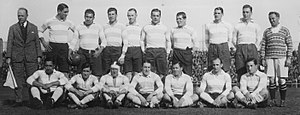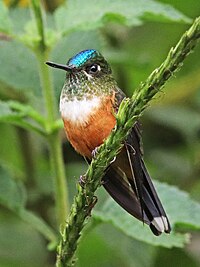Gapolania national rugby union team
 | |||
| Nickname(s) | Kolibri | ||
|---|---|---|---|
| Union | Gapolanese Rugby Union | ||
| Head coach | Jovan Sandjić | ||
| Captain | Alessandro Legastru | ||
| Home stadium | Tifone Stadium | ||
| |||
| First international | |||
(Zeta, Gapolania; 12 July 1927) | |||
| Biggest defeat | |||
(23 September, 1997) | |||
| World Cup | |||
| Appearances | 1 (2021) | ||
The Gapolania national rugby union team is the rugby union team of Gapolania. Unofficially known as Kolibri (Hummingbirds), the team competes in the Kylaris rugby world cup, appearing for the first time in 2021 Rugby World Cup.
The national team was created in the summer of 1925 in the city of Zeta and is commonly associated with the region of Nuova Novalia, played initially by Novalian and Carinthian immigrants and their descendants. Their first match was in 1927, when they played against Nuvania and lost 5 to 33. Gapolania continued to play internationally, usually against Nuvania, Satavia or Satucin but has lost majority of its matches, winning only 53 of 258 of their test matches. In 2020, for the first time in the sport's history in the nation, Gapolania managed to qualify to the 2021 Kylaris World Rugby Cup.
The team's main stadium is Tifone Stadium in Zeta, used for training and most international matches. The popularity of the rugby union in Gapolania is low but has increased significantly in the 2010s, following a series of successes the team achieved under the coaching of Jovan Sandjić, a former rugby union player. The sport's significance is higher in the Novalian and Carinthian-speaking parts of Gapolania and many players are of of that ancestry. The team's emblem is the hummingbird and their colors are navy and yellow, mirroring the national colors of the republic.
History
Rugby union first appeared in Gapolania in early 20th century, however it never gained as much attention as soccer. Several teams, including still-functioning Zeta Lions and Patrasi Rugby Team, formed in the first decade of the century. The national team, however, took another 20 years to be formed. This was mostly due to the anti-Novalian policies that forced the Gapolanese population to speak solely Vespasian and suppressed Novalian and Carinthian customs and, as rugby union became more popular within immigrants of these origins, the sport was heavily targeted as an "unhealthy tradition". Only in 1924, when Marco Fabrizio Moro established the national rugby union association, the players were able to create a nationally recognized team.
In the first years of its operation, the team played mostly against Nuvania, Satavia and Satucin, losing most of the games. Despite that, the sport gained a significant attention, particularly within the Novalian-speaking regions of the country. The national team stopped playing during the Great War and re-assumed its competition in 1937, playing in all of the rugby world cup qualifications. The team came close to advance to the main event on two occasions: in 195X and in 195X. Since 1960s, Gapolania has been continuously falling in the world ranking, to the point of losing X-Y against someone in 197X.
The sport lost most of the coverage in the late 1900s, losing out to more popular soccer and volleyball, where the national teams often qualified for the international events. In 2007 the national rugby union association was granted 30'000$ as a part of the Millenial Sports and Culture Fund. This allowed the union to hire more experienced coaches and invest in the stadium's equipment, which wasn't adjusted properly to answer the team's needs. In 2012, Jovan Sandjić, a former team's captain became the coach and, year later, Kolibri managed to score their first major win against someone in 60 years. In 2020, Gapolania advanced to the 2021 Kylaris Rugby Cup, marking their first appearance in the event.
Name and colors
The term Kolibri first appeared in 1949, when the Gapolanese sports journalist, Filipe Derko, described the team as "hummingbirds - inconspicuous, yet strong, this team will win us the world one day" during the match against Satucin. Despite the overly optimistic review, the name attached to the players and was often used as a cheer. Kolibri itself is a mix of Vespasian colibrì and Novalian kolibrić. Sometimes, the national team is called the yellowbirds, in reference to their kit and badge colors.
Gapolania alternated yellow and dark blue jerseys in their first international games. After the Great War, the association's president, Andrej Koroština, proposed the team wear navy blue tops with yellow shorts. In 1984, several stripes were added to the jerseys, while the secondary kits were changed to involve yellow and white. In 2009, the team found a sponsor in Sentax Gapolania and new kits were designed, including dark blue and yellow stripes.
1925–1936 home
|
1925-1936 guest
|
1936-1984 home
|
1936–1984 guest
|
1984-2008 home
|
1984-2008 guest
|
Records
Below is a table of test matches played by Gapolania up to 14th December 2020. The country played 258 international matches.
| Opponent | Played | Won | Lost | Drawn | Win % |
|---|---|---|---|---|---|
| 2 | 1 | 1 | 0 | 50.00% | |
| 12 | 4 | 7 | 1 | 36.36% | |
| 15 | 5 | 9 | 1 | 33.33% | |
| 9 | 0 | 9 | 0 | 0.00% | |
| 7 | 0 | 7 | 0 | 0.00% | |
| Template:Country data Estmere | 11 | 1 | 10 | 0 | 9.09% |
| 21 | 2 | 17 | 2 | 9.52% | |
| 0 | 0 | 0 | 0 | 0.00% | |
| 7 | 0 | 7 | 0 | 0.00% | |
| 6 | 0 | 6 | 0 | 0.00% | |
| Jossia | 23 | 4 | 18 | 1 | 17.39% |
| 39 | 8 | 28 | 3 | 7.69% | |
| 34 | 4 | 28 | 0 | 11.76% | |
| 25 | 11 | 12 | 2 | 44.00% | |
| 4 | 2 | 2 | 0 | 50% | |
| 1 | 0 | 1 | 0 | 0.00% | |
| 19 | 8 | 11 | 0 | 42.11% | |
| 13 | 4 | 8 | 1 | 30.77% |
Players
On 7th December, Gapolania named 31-man squad for the 2021 Kylaris Rugby Cup.
| Player | Position | Date of birth (age) |
|---|---|---|
| Milan Jedlinić | Hooker | 11 June 1993 (age 27) |
| Robert Salenko | Hooker | 4 April 1985 (age 35) |
| Viktor Vranjić | Hooker | 22 April 1990 (age 30) |
| Martin Abrimović | Prop | 2 December 1996 (age 24) |
| Giacomo di Ellorio | Prop | 2 May 1991 (age 29) |
| Martin Hrgović | Prop | 7 September 1987 (age 33) |
| Aleksandar Kasprović | Prop | 30 April 1997 (age 23) |
| Antero Presutti | Prop | 24 November 1995 (age 25) |
| Fabio Balaso | Lock | 21 April 1992 (age 28) |
| Mladen Brala | Lock | 3 February 1994 (age 26) |
| Andreo Lanza | Lock | 13 August 1988 (age 32) |
| Vukasin Milović | Lock | 10 April 1999 (age 21) |
| Danielle Antonović | Back row | 3 March 1988 (age 32) |
| Nikita Dvorec | Back row | 11 June 1994 (age 26) |
| Paolo Moneggini | Back row | 29 June 1994 (age 26) |
| Aleksandar Todevski | Back row | 9 February 1989 (age 31) |
| Mauro Verrata | Back row | 24 May 1995 (age 25) |
| Guido Demàgazzu | Scrum-half | 13 November 1992 (age 28) |
| Jonas Martin Hedelberg | Scrum-half | 30 August 1990 (age 30) |
| Aleksandar Perović | Scrum-half | 11 December 1998 (age 22) |
| Domenico Pegàsia | Fly-half | 26 May 1996 (age 24) |
| Arturo Tolda | Fly-half | 8 June 1988 (age 32) |
| Emmanuel Vinelli | Fly-half | 15 February 1990 (age 30) |
| Gian Federzoni | Centre | 15 August 1994 (age 26) |
| Alessandro Legastru (c) | Centre | 10 May 1988 (age 32) |
| Ivan Nikita Serdak | Centre | 27 March 1993 (age 27) |
| Toše Malimov | Wing | 4 July 1998 (age 22) |
| Giuseppe di Sarita | Wing | 8 January 1990 (age 30) |
| Carlo Unero | Wing | 11 September 1992 (age 28) |
| Adrian Kaminović | Fullback | 22 November 1989 (age 31) |
| Martin Zelenskiy | Fullback | 16 June 1991 (age 29) |
Coaches
The national rugby union team was commonly coached by its captain up until 1968, when, following a series of defeats, the GRUA named the team's former captain, Aleksandar Jakubović, its new head coach.
- Aleksandar Jakubović: 1968–1977
- Davide Follori: 1977-1978
- Michele Bernardou: 1978-1980
- Vukasin Miltanović: 1980-1984
- Colin O'Leary: 1984-1985
- Vukasin Miltanović: 1985-1988
- Isaaco Marinèzzu: 1988-1991
- Dušan Karantjak: 1991-2000
- Mauricio Derico-Levadenza: 2000-2003
- Alessandro Pastraci: 2003-2004
- Tomaš Volak: 2004-2007
- Kim Che-Song: 2007-2012
- Jovan Sandjić: 2012-

